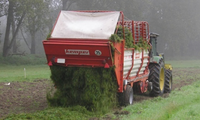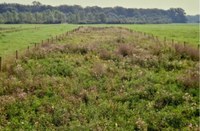Goal achieved? - Plant material transfer in restoration practice
Project description
Species-rich grassland fulfills a wide range of functions. It is not only a habitat for many plant and animal species, but also plays an important role for the aesthetic and recreational value of our landscape. Although it is mainly of human origin in Central Europe, species-rich grassland is mostly endangered by human activities today, such as intensification, change or abandonment of land use. Especially communities of special sites such as floodplains, moors or rocky habitats are acutely threatened from vanishing. The isolation of resting habitats hampers or prevents genetic mixture and propagation to new locations, even if these are used appropriately. Therefore, methods of creating new species-rich grassland or improving existing grassland are indispensable. One of the classical methods for this is the mowing and transfer of plant material from species-rich donor sites.



f.l.t.r.: plant material transfer; early-stage restored site; developed restored site
In the project "Goal achieved? - Plant material transfer in restoration practice", which is funded by the German Federal Environmental Foundation (DBU), we want to expand the scientific knowledge about this method. One important component is the long-term observation of restoration projects. For that, sites in the floodplain of the Northern Upper Rhine in Hesse, which have received species-rich donor material, are to be investigated again 13-16 years after the restoration measures. In a second step, we plan to assess the success of species establishment for a broader spectrum of practical restoration projects with transfer of plant material. From these findings, supported by comparisons with the literature, success factors with respect to different site conditions are to be derived. In addition, we intend to compare and link the gained knowledge with experiences from nature conservation practice via interviews with pracitioners. These findings and the findings from the field studies are to be presented to the public. That way, we aim to make a contribution to grassland restoration which is successful on the long run, to secure the survival of these precious habitats for future generations.
Involved scientists: Leonhard Sommer, Sarah Harvolk-Schöning, Yves Klinger, Till Kleinebecker, Tobias W. Donath (Christian Albrechts University, Kiel), Bente Castro Campos (ZEU)
Duration: 2020 - 2023
Funding institution: German Federal Environmental Foundation (Deutsche Bundesstiftung Umwelt, DBU)
